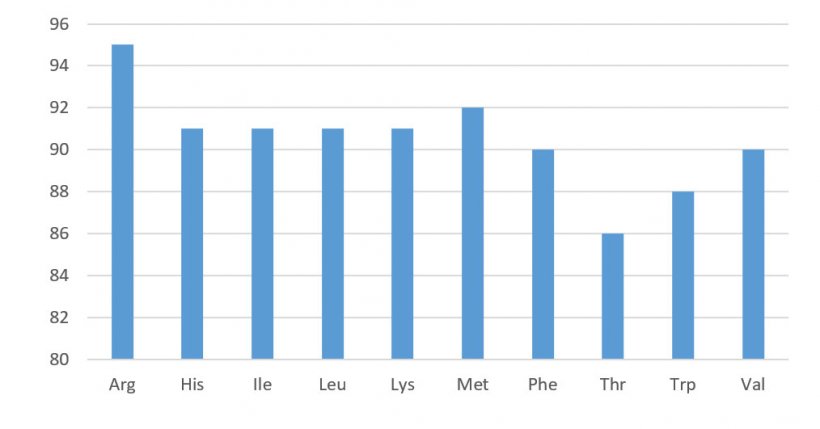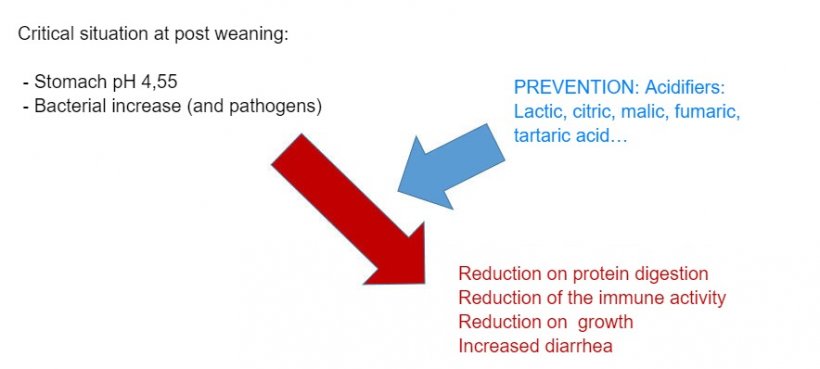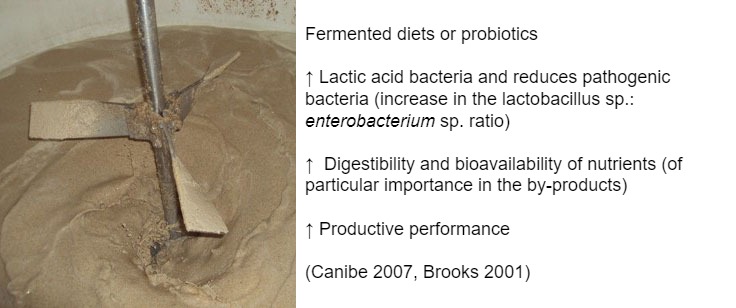Two-thirds of the costs of obtaining a carcass today are dedicated to the feeding of pigs (Pipestone, 2014). Therefore, one of the main parameters where we can have more influence to increase the productivity of the swine industry is digestion and absorption of nutrients. In addition, another important benefit of stimulating digestion is the improvement of gut health, which can bring us significant improvements in the quality of the carcass, less environmental pollution, reduction of the symptoms associated to intestinal malabsorption and the suppression of putrefactive bacteria that generate toxic compounds in the intestine.
There are many nutritional strategies that can be used to improve the process of digestion and/or absorption of nutrients. We will discuss some of the most frequently used in the industry.

A strategy widely used in early ages is to use ingredients that are highly palatable and of elevated biological value, for example, to provide proteins through hydrolysates of mucosa, porcine plasma, or whey. These ingredients have demonstrated their capacity to increase the productive results and to increase the value of the diet through other functions, such as their antimicrobial capacity or immunostimulation. However, these ingredients are practically only used in the initial stages, due to their high economic cost. Alternatively, processed soy products such as hydrolyzed protein concentrates are also a way to improve digestion, because of their high protein content and high digestibility, due to their low level of anti-nutritional factors (figure 1).

Figure 1: Amino acid digestibility profile in soy concentrates (standardized ileal digestibility). NRC 2012
The reduction of protein levels in the feed after weaning (<180g / kg), can be a way to facilitate its digestion and avoid the presence of undigested protein in the digesta. This protein would promote bacteria that ferment it, producing potentially toxic compounds, and ultimately causing post-weaning diarrhea. However, it is necessary to supplement the ration with synthetic essential amino acids, following the ideal protein profile, to carry out this decrease in protein levels without affecting the productive performance. Moreover, to facilitate the digestion of protein in early-life stages, we can also consider the inclusion of acidifiers (figure 2), or diets with a low buffer capacity; providing sufficient acidity for efficient digestion in the stomach (Pérez, 2103).

Figure 2: .The acidification of the digesta is also a good strategy to improve digestion, especially in post-weaning piglets because their endogenous capacity is very limited. By adding an acidifier in the diet, the reduction on protein digestion and its effects on immunity and productive parameters are avoided.
Another way to improve the utilisation of the diet is the addition of exogenous enzymes (Table 1). Currently, there are several enzymes on the market, such as phytases, xylanases, β-glucanases, and proteinases. Its use has been widespread for a long time in poultry. Nowadays there is also an increasing trend to use them in the pig industry, as they are used to increase the digestive capacity of the animals. They are attributed several benefits in the digestion process, mainly the degradation of the specific bonds of the ingredients that are not correctly hydrolyzed by endogenous enzymes, and the degradation of anti-nutritive factors (Bedford, 1999). In this sense, their popularity is increasing because they open the door to decreasing the cost of the diet, allowing the incorporation of cheaper ingredients, or the addition of higher levels of inclusion of certain ingredients, that the pig could not digest on its own.
Table 1. Tipos de enzimas, sustrato y materias primas dónde actúan. Adaptado de Ravindran, 2010
| Enzyme | Substrate | Raw material |
|---|---|---|
| β-glucanase | β-glucans | Barley, oats, rye |
| Xylanases | Arabinoxylans | Wheat, rye, barley, vegetal fiber |
| α-galactosidase | Oligosaccharides | Soybean meal, grain legumes |
| Phytase | Phytic acid | All feeds of plant origin |
| Proteases | Proteins | All vegetable protein sources |
| Amylases | Starch | Cereal grains and grain legumes |
| Lipases | Lipids | Feed Lipids and lipid supplement |
| Mannose, cellulases, hemicellulases, pectinases | Cell wall (fiber) |
Vegetable raw materials |
Furthermore, another strategy to improve the bioavailability of nutrients is through the action of certain microorganisms, either in the same diet (fermented diets, figure 3), incorporating them directly into the gastrointestinal tract of the animal (probiotics), or stimulating their growth in a specific way (prebiotics). On the one hand, it is well known that the hydrolysis of the diet by means of bacterial enzymes (phytases, lipases, amylases or proteases) can favor absorption (Gomes and Malcata, 1999). On the other hand, it has also been described that the bacterial population of the intestine can synthesize nutrients de novo, such as the essential amino acid lysine (Torrallardona et al., 2003) or vitamins (Arunachalam, 1999); thanks to the bacterial fermentation of carbohydrates. It is also interesting to mention that certain beneficial microorganisms can act indirectly on the digestive function or the intestinal architecture of the animal; for example stimulating the secretion of hormonal peptides, causing hyperpla*sia of the intestinal epithelium, stimulating fermentation or acidifying the environment.

Figure 3: It may also be interesting to encourage fermentation through the use of pre-fermented or probiotic diets. They are attributed many benefits as an increase in favorable microbiota (improvement of the Lactobacillus: enterobacteria ratio), digestive improvements and finally improvements in the productive performance of the animal.
The strategies reviewed in this article to stimulate digestion, are vital in piglets at weaning because they are immature, with a low capacity to produce HCl in the stomach and they have a limited production of enzymes. However, they can also be interesting in fattening pigs with a more developed digestive system, especially when diets with a high energy density are used (Meng et al., 2010 and Zang et al., 2015) or with feeds with little nutritional value (Bedford, 2015). On these occasions, it will be important to assess the cost-benefit ratio of implementing nutritional strategies that allow pigs to efficiently digest these diets, which would not be available to them through their own resources.



